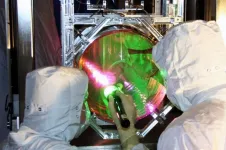(Press-News.org) CAMBRIDGE, MA -- To the human eye, most stationary objects appear to be just that -- still, and completely at rest. Yet if we were handed a quantum lens, allowing us to see objects at the scale of individual atoms, what was an apple sitting idly on our desk would appear as a teeming collection of vibrating particles, very much in motion.
In the last few decades, physicists have found ways to super-cool objects so that their atoms are at a near standstill, or in their "motional ground state." To date, physicists have wrestled small objects such as clouds of millions of atoms, or nanogram-scale objects, into such pure quantum states.
Now for the first time, scientists at MIT and elsewhere have cooled a large, human-scale object to close to its motional ground state. The object isn't tangible in the sense of being situated at one location, but is the combined motion of four separate objects, each weighing about 40 kilograms. The "object" that the researchers cooled has an estimated mass of about 10 kilograms, and comprises about 1x1026, or nearly 1 octillion, atoms.
The researchers took advantage of the ability of the Laser Interfrometer Gravitational-wave Observatory (LIGO) to measure the motion of the masses with extreme precision and super-cool the collective motion of the masses to 77 nanokelvins, just shy of the object's predicted ground state of 10 nanokelvins.
Their results, appearing today in Science, represent the largest object to be cooled to close to its motional ground state. The scientists say they now have a chance to observe the effect of gravity on a massive quantum object.
"Nobody has ever observed how gravity acts on massive quantum states," says Vivishek Sudhir, assistant professor of mechanical engineering at MIT, who directed the project. "We've demonstrated how to prepare kilogram-scale objects in quantum states. This finally opens the door to an experimental study of how gravity might affect large quantum objects, something hitherto only dreamed of."
The study's authors are members of the LIGO Laboratory, and include lead author and graduate student Chris Whittle, postdoc Evan Hall, research scientist Sheila Dwyer, Dean of the School of Science and the Curtis and Kathleen Marble Professor of Astrophysics Nergis Mavalvala, and assistant professor of mechanical engineering Vivishek Sudhir.
Precision pushback
All objects embody some sort of motion as a result of the many interactions that atoms have, with each other and from external influences. All this random motion is reflected in an object's temperature. When an object is cooled down close to zero temperature, it still has a residual quantum motion, a state called the "motional ground state."
To stop an object in its tracks, one can exert upon it an equal and opposite force. (Think of stopping a baseball in mid-flight with the force of your glove.) If scientists can precisely measure the magnitude and direction of an atom's movements, they can apply counteracting forces to bring down its temperature -- a technique known as feedback cooling.
Physicists have applied feedback cooling through various means, including laser light, to bring individual atoms and ultralight objects to their quantum ground states, and have attempted to super-cool progressively larger objects, to study quantum effects in bigger, traditionally classical systems.
"The fact that something has temperature is a reflection of the idea that it interacts with stuff around it," Sudhir says. "And it's harder to isolate larger objects from all the things happening around them."
To cool the atoms of a large object to near ground state, one would first have to measure their motion with extreme precision, to know the degree of pushback required to stop this motion. Few instruments in the world can reach such precision. LIGO, as it happens, can.
The gravitational-wave-detecting observatory comprises twin interferometers in separate U.S. locations. Each interferometer has two long tunnels connected in an L-shape, and stretching 4 kilometers in either direction. At either end of each tunnel is a 40-kilogram mirror suspended by thin fibers, that swings like a pendulum in response to any disturbance such as an incoming gravitational wave. A laser at the tunnels' nexus is split and sent down each tunnel, then reflected back to its source. The timing of the return lasers tells scientists precisely how much each mirror moved, to an accuracy of 1/10,000 the width of a proton.
Sudhir and his colleagues wondered whether they could use LIGO's motion-measuring precision to first measure the motion of large, human-scale objects, then apply a counteracting force, opposite to what they measure, to bring the objects to their ground state.
Acting back on back-action
The object they aimed to cool is not an individual mirror, but rather the combined motion of all four of LIGO's mirrors.
"LIGO is designed to measure the joint motion of the four 40-kilogram mirrors," Sudhir explains. "It turns out you can map the joint motion of these masses mathematically, and think of them as the motion of a single 10-kilogram object."
When measuring the motion of atoms and other quantum effects, Sudhir says, the very act of measuring can randomly kick the mirror and put it in motion -- a quantum effect called "measurement back-action." As individual photons of a laser bounce off a mirror to gather information about its motion, the photon's momentum pushes back on the mirror. Sudhir and his colleagues realized that if the mirrors are continuously measured, as they are in LIGO, the random recoil from past photons can be observed in the information carried by later photons.
Armed with a complete record of both quantum and classical disturbances on each mirror, the researchers applied an equal and opposite force with electromagnets attached to the back of each mirror. The effect pulled the collective motion to a near standstill, leaving the mirrors with so little energy that they moved no more than 10-20 meters, less than one-thousandth the size of a proton.
The team then equated the object's remaining energy, or motion, with temperature, and found the object was sitting at 77 nanokelvins, very close to its motional ground state, which they predict to be 10 nanokelvins.
"This is comparable to the temperature atomic physicists cool their atoms to get to their ground state, and that's with a small cloud of maybe a million atoms, weighing picograms," Sudhir says. "So, it's remarkable that you can cool something so much heavier, to the same temperature."
"Preparing something in the ground state is often the first step to putting it into exciting or exotic quantum states," Whittle says. "So this work is exciting because it might let us study some of these other states, on a mass scale that's never been done before."
INFORMATION:
This research was supported, in part, by the National Science Foundation.
Research conducted by Qiang et al has discovered a link between a protein in red blood cells and age-related decline in cognitive performance. Published in the open access journal PLOS Biology on 17th June 2021, the study shows that depleting mouse blood of the protein ADORA2B leads to faster declines in memory, delays in auditory processing, and increased inflammation in the brain.
As life expectancies around the world increase, so are the number of people who will experience age-related cognitive decline. Because the amount of oxygen in the blood also declines with age, the team hypothesized that ...
CLEVELAND--Case Western Reserve University researchers studying prions--misfolded proteins that cause lethal incurable diseases--have identified for the first time surface features of human prions responsible for their replication in the brain.
The ultimate goal of the research is to help design a strategy to stop prion disease in humans--and, ultimately, to translate new approaches to work on Alzheimer's and other neurodegenerative diseases.
Scientists have yet to discover the exact cause of Alzheimer's disease, but largely agree that protein issues play a role in its emergence and progression. Alzheimer's disease afflicts more than 6 million people in the U.S., and the Alzheimer's Association ...
UTICA, NY -- More than 2 million coronary artery stents are implanted each year to help protect or restore normal blood flow to the heart, to treat patients suffering from angina or a heart attack due to coronary artery disease (CAD). While stents are highly effective and safe devices, scarring or clotting of unhealed stents can occur in a small percentage of subjects, leading to complications such as stent restenosis or thrombosis, which can be life-threatening. At present, approaches to understand stent healing based on their biological clotting status is unavailable in patients.
To devise a potential solution to this problem, Dr. Jason McCarthy, an Associate Professor at the Masonic Medical Research Institute (MMRI), and his team have developed a fluorescent probe that binds ...
A long-term passive rewilding study has shown that natural woodland regeneration could make a significant contribution to meeting the UK's ambitious tree planting targets - potentially at no cost and within relatively short timescales.
The research, led by the UK Centre for Ecology & Hydrology (UKCEH), found natural growth due to seed dispersal by birds, mammals and wind can produce biodiverse and resilient woodland.
Woodland development can be rapid, while avoiding the cost, management and plastic tubing involved in planting schemes.
The study - published in the journal PLOS ONE - found that after just 15 years, previously bare agricultural ...
Physicists at Ludwig-Maximilian University in Munich (LMU) and the Max Planck Institute for Quantum Optics (MPQ) have used ultrashort laser pulses to probe the dynamics of photoelectron emission in tungsten crystals.
Almost a century ago, Albert Einstein received the Nobel Prize for Physics for his explanation of the photoelectric effect. Published in 1905, Einstein's theory incorporated the idea that light is made up of particles called photons. When light impinges on matter, the electrons in the sample respond to the input of energy, and the interaction gives rise to what is known as the photoelectric effect. Light quanta (photons) are absorbed by the ...
Lugano, Switzerland, 17 June 2021 - Adding an immune checkpoint inhibitor to anti-HER2 treatment in breast cancer does not improve pathological complete response (pCR), according to the primary analysis of the IMpassion050 trial presented today during the ESMO Virtual Plenary. (1) The phase III trial is the first to report data comparing a neoadjuvant anti-HER2 based regimen with or without the anti-PD-L1 antibody atezolizumab in patients with high-risk, HER2-positive early breast cancer.
The standard treatment for high-risk, HER2-positive early breast cancer is dual anti-HER2 blockade plus chemotherapy. While antibody therapy may enhance innate and adaptive immunity and activate cellular cytotoxicity, there is evidence ...
(Boston)--An intrauterine fracture is a rare finding during routine prenatal imaging. This condition can be due to maternal trauma, genetic disorders of the skeleton, as well as other predisposing maternal metabolic and vascular disorders. Genetic disorders that have previously been reported to cause intrauterine fracture include brittle bone disease (osteogenesis imperfecta or OI), osteopetrosis, hypophosphatasia and Ehlers-Danlos syndrome (EDS).
Now for the first time, researchers from Boston University School of Medicine (BUSM) report a new genetic cause, unrelated to OI, for the 23 fractures that occurred in-utero to a mother with EDS hypermobility type.
EDS is a disease that weakens the bones and connective tissues ...
New study challenges long-standing assumptions about disease severity in infants, and suggests that standard qPCR interpretations underestimate the true burden of other highly contagious diseases, such as COVID-19 and influenza.
Pertussis, also known as "whooping cough," remains a significant cause of death in infants and young children around the world and, despite global vaccination programs, many countries are experiencing a resurgence of this highly contagious disease.
A new study by Boston University School of Public Health and the University of Georgia's Odum School of Ecology presents evidence that could help explain this ...
Bottom Line: Genetic mutations indicative of DNA damage were associated with high red meat consumption and increased cancer-related mortality in patients with colorectal cancer.
Journal in Which the Study was Published: Cancer Discovery, a journal of the American Association for Cancer Research
Author: Marios Giannakis, MD, PhD, an assistant professor of medicine at Harvard Medical School and a physician at Dana-Farber Cancer Institute
Background: "We have known for some time that consumption of processed meat and red meat is a risk factor for colorectal cancer," said Giannakis. The International Agency for Research on Cancer declared that processed meat was carcinogenic and that red meat was probably carcinogenic to humans in 2015.
Experiments ...
HOUSTON ? Preclinical research from The University of Texas MD Anderson Cancer Center finds that although glioblastoma stem cells (GSCs) can be targeted by natural killer (NK) cells, they are able to evade immune attack by releasing the TFG-β signaling protein, which blocks NK cell activity. Deleting the TFG-β receptor in NK cells, however, rendered them resistant to this immune suppression and enabled their anti-tumor activity.
The findings, published today in the Journal of Clinical Investigation, suggest that engineering NK cells to resist immune suppression may be a feasible path ...



